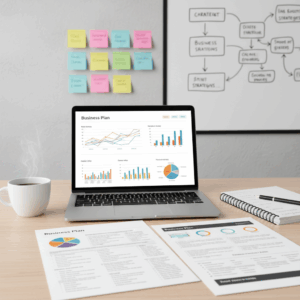Fundamentals of financial crisis prediction
The prediction of financial crises It is based on detecting early signals that anticipate economic imbalances. This requires analyzing complex and dynamic market patterns.
Traditional methods based on econometric models offer a starting point, but often fail to capture the full nonlinear and volatile nature of global finance.
Therefore, the integration of technologies such as artificial intelligence has revolutionized this field, allowing large volumes of data to be analyzed to improve predictive capacity.
Traditional econometric models and limitations
Econometric models have been the basis for anticipating crises through the analysis of variables such as inflation or public debt, primarily using logistic regression.
These models can classify simple scenarios, but their effectiveness diminishes in the face of the complexity and nonlinearity of financial behavior in real-life contexts.
Furthermore, traditional models often struggle to incorporate qualitative or emotional variables that influence the market, limiting their predictive scope.
Role of artificial intelligence in prediction
Artificial intelligence, especially deep learning, detects hidden relationships and patterns in big data, improving the accuracy of financial crisis predictions.
Algorithms such as neural networks or Random Forest models can process time series, news, and transaction data, better anticipating risks.
This technology allows for the integration of behavioral analysis and non-traditional variables, strengthening the ability to predict critical events and reduce economic impacts.
Key techniques to anticipate financial crises
To anticipate financial crises, various techniques are applied that analyze economic and financial data from different perspectives. These techniques allow for anticipating imbalances and making timely decisions.
The combination of classical statistical methods and advanced technologies such as deep learning has significantly improved predictive power. Each technique offers advantages depending on the type of information available.
Furthermore, incorporating behavioral analysis into these techniques helps us better understand the emotions and irrationalities that can trigger crises in financial markets.
Logistic regression and its application
Logistic regression is a classic technique used to classify crisis or non-crisis scenarios based on relevant economic indicators. It is easy to interpret and apply.
This model analyzes variables such as interest rates, inflation, and public debt, allowing for systematic identification of crisis probabilities. However, its simplicity limits its effectiveness with nonlinear data.
Despite its limitations, logistic regression remains useful for establishing a basic evaluation framework that is complemented by more complex methods to improve accuracy.
Neural networks and deep learning
Neural networks and deep learning are artificial intelligence algorithms that identify complex patterns in large volumes of financial data, including time series and news.
These techniques allow for the detection of non-obvious relationships in markets and offer more accurate predictions than traditional methods, anticipating crisis signals more effectively.
Their ability to handle heterogeneous and unstructured data makes them indispensable today for understanding global financial dynamics and their risks.
GARCH and Random Forest models
GARCH models are used to analyze and predict financial volatility, a key factor in crisis detection. They capture the temporal dynamics of markets with great accuracy.
Random Forest is a machine learning method that combines multiple decision trees to improve the accuracy of predicting critical events and handling large, complex data sets.
Both models complement neural networks and logistic regression, allowing for a more robust assessment of financial stability in different scenarios.
Behavioral Finance Analysis
Behavioral finance analysis incorporates the study of the irrational emotions and behaviors of investors that often trigger financial bubbles and panics.
This perspective allows us to identify signals that are not captured by purely quantitative models, anticipating crises from a psychological and social perspective.
Integrating this analysis with statistical techniques improves the ability to anticipate and develop strategies to mitigate negative impacts on the financial system.
Indicators and variables used in the prediction
To anticipate financial crises, it is essential to identify economic and financial indicators that reflect the health of the system. These indicators provide early warning signs of imbalances.
In addition to quantitative data, analysis of investor behavior and emotions plays a key role, as irrational decisions can precipitate unexpected crises.
The combination of traditional and behavioral variables allows for a more comprehensive and accurate approach to predicting critical financial events.
Relevant economic and financial indicators
Key indicators include interest rates, inflation, public debt levels, and trade balances, which reflect the country's macroeconomic and financial stability.
Liquidity, exchange rates, and market volatility indicators are also considered, which are essential for detecting potential disruptions in the financial system.
Constant monitoring of these indicators makes it possible to anticipate imbalances that could trigger a crisis, facilitating preventive decision-making.
Investor behavior and emotions
Emotions such as fear and euphoria influence investment decisions, generating collective behaviors that can amplify financial risks.
Behavioral analysis studies these patterns, identifying signs of speculative bubbles or panics that are not captured by traditional models.
Including these emotional variables in the forecast improves the ability to anticipate crises by reflecting the psychological dimension of the financial market.
Practical applications and current challenges
The financial institutions and central banks use advanced models to monitor risks and issue early warnings of crises. This allows them to implement effective preventive policies.
The use of artificial intelligence makes it possible to analyze large volumes of data in real time, improving the response capacity to potential economic imbalances.
These organizations integrate financial indicators, macroeconomic variables, and behavioral analysis to better understand market dynamics and reduce future damage.
Use by financial institutions and central banks
Financial institutions use predictive models to manage liquidity and prevent systemic collapses. Central banks use them to design timely monetary policies.
The ability to anticipate crises allows for adjusting reserves, modifying interest rates, and controlling variables such as inflation and the exchange rate.
These financial agents also monitor non-traditional indicators to detect sudden changes in investor behavior and panics that could precipitate a crisis.
Limitations and improvements in prediction
Although advanced, current techniques face limitations such as the inherent uncertainty in economic data and the difficulty in modeling complex human behavior.
Continuous improvement involves better integrating qualitative data and multidisciplinary approaches, combining econometrics, artificial intelligence, and behavioral finance.
Furthermore, the development of more adaptive models and transparency in the methods used are vital to increasing confidence and effectiveness in prediction.






